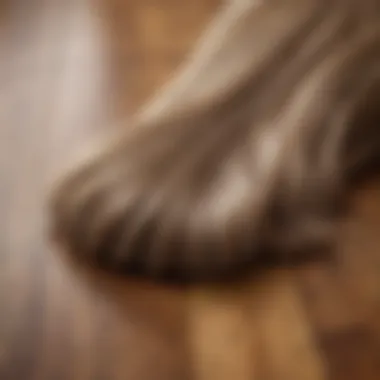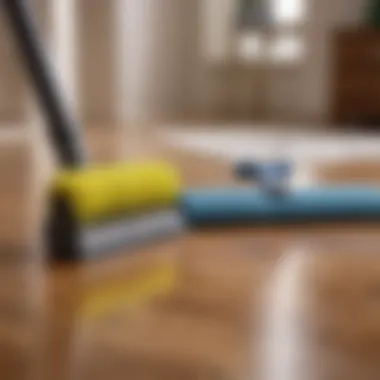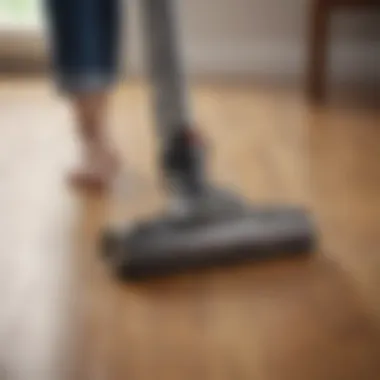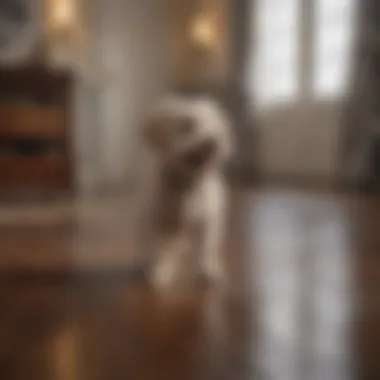Effective Strategies for Managing Dog Hair on Hardwood Floors


Intro
Dog ownership comes with many joys, but it also introduces certain challenges, especially regarding cleanliness in the home. One of the most persistent issues pet owners face is managing dog hair, particularly when it comes to hardwood floors. These surfaces are both aesthetically pleasing and easy to maintain, but they require special attention to remain free of pet fur.
This article aims to address the complexities of dog hair on hardwood floors. It will explore the characteristics of hardwood, the nature of dog hair, and provide not just effective cleaning strategies but also preventive measures to minimize shedding. The intention is to equip pet owners with practical solutions and tools that can help maintain a clean and inviting living environment while preserving the integrity of their flooring.
Understanding the ongoing battle against dog hair is essential for homeowners who value both their pets and their living space. By learning to manage this common issue, they can enhance their home’s appearance and ensure a more harmonious coexistence with their furry companions.
Preface to Hardwood Floors and Pet Ownership
Maintaining a home with hardwood floors while owning a dog can raise many concerns for pet owners. This article discusses the intersecting aspects of hardwood flooring and dog ownership. It offers strategies to deal with the challenges that come from having a furry companion while maintaining the beauty and integrity of hardwood surfaces.
Hardwood floors provide a durable and elegant touch to homes. Their aesthetics greatly enhance interior design. However, these floors can also pose specific problems for dog owners, primarily due to the inevitable shedding that occurs. Understanding this relationship is vital in finding practical solutions. Cleaning and maintaining hardwood floors involves considerations to ensure both the floors and the pets are well-managed.
Understanding Hardwood Floors
Hardwood floors are a popular choice among homeowners for several reasons. They offer a classic and warm appearance that suits various decor styles. The variety in wood types and finishes allows personalization in every home. However, its glossy surface can bring out another aspect — visibility of dog hair.
Most hardwood floors are smooth, making them susceptible to showing dirt and hair. Furthermore, they require specific cleaning methods that differ from those used on carpets. This often presents a dilemma for those who want to enjoy a pet-friendly home without compromising the floor's appearance. By knowing the characteristics of hardwood, owners can better appreciate how to maintain these surfaces effectively when living with dogs.
The Role of Dogs in the Home
Dogs play an essential part in the lives of many individuals and families. They offer companionship, loyalty, and joy. Having a dog can bring life into a home, encouraging activities and creating a nurturing environment. They often become beloved family members that need to be cared for and managed alongside home upkeep.
Yet, owning a dog involves understanding their needs and behaviors. Regular shedding is a natural process that varies among breeds. The impact on hardwood floors from this shedding can be significant if not addressed properly. Pet owners must come to grips with the reality of extra cleaning and maintenance to preserve the look of their floors. By creating a proactive plan for managing dog hair, it is possible to maintain a beautiful home while cherishing the bond with a canine companion.
The Nature of Dog Hair
Understanding the nature of dog hair is essential for managing its presence on hardwood floors. Both the characteristics of dog hair and the seasonal shedding patterns play significant roles in how we approach cleaning and maintenance. This knowledge helps homeowners develop effective strategies to maintain the beauty of their interiors while accommodating their pets.
Dog Hair Characteristics
Dog hair varies greatly among breeds, impacting how it interacts with hardwood floors. The texture and length of the hair can affect its visibility and the ease of cleaning. For instance, short-haired breeds like Beagles tend to shed hairs that are finer and may stick to surfaces more easily. In contrast, long-haired breeds such as Golden Retrievers shed thicker strands that can be more easily collected.
Dog hair is composed mainly of keratin, which gives it a durable structure, but it also possesses natural oils that help protect the hair. These oils can cause dog hair to cling to hardwood surfaces, making it harder to remove. Additionally, dog hair can trap dirt, dust, and allergens, which can compound cleaning challenges and require more thorough maintenance routines.
Seasonal Shedding Patterns
Dogs typically experience seasonal shedding, which can be influenced by factors including climate and hormonal changes. Many breeds shed fur in the spring and fall as they transition between winter and summer coats. This seasonal shedding can lead to significant hair accumulation in the home if not properly managed.
Understanding the timing of shedding can help homeowners prepare for increased cleaning efforts. During heavy shedding seasons, a more rigorous cleaning routine may be necessary. This might include frequent vacuuming and additional grooming sessions to minimize the amount of hair that ends up on the floors.


Knowing that shedding patterns may differ by breed and individual dog can help tailor cleaning strategies effectively. For example, the shedding tendencies of a Labrador Retriever should be managed differently than those of a Poodle.
In summary, being aware of dog hair characteristics and seasonal shedding patterns enables pet owners to take proactive measures. This knowledge leads to more efficient cleaning practices, ensuring a harmonious environment between pets and hardwood floors.
Impact of Dog Hair on Hardwood Floors
Effects of Dog Hair on Floor Aesthetics
Dog hair can drastically alter the visual appeal of hardwood flooring. Unlike carpets, which can hide some hair, hardwood surfaces showcase and reflect every strand. This visibility can be especially pronounced in homes with darker wood finishes. Accumulated dog hair can create an impression of neglect, undermining the elegance that well-maintained hardwood floors should convey.
Regular removal of dog hair helps maintain a clean environment and enhances the aesthetic quality of the space. As homeowners clean, they allow their floors to radiate their true finish and luster, reinforcing a positive atmosphere. This routine can also bring satisfaction to those who host visitors or engage in home gatherings, ensuring the space remains welcoming.
Potential Damage to Floor Finish
In addition to aesthetic concerns, the presence of dog hair can pose a serious threat to the finish of hardwood floors. When dog hair accumulates and mixes with dust and dirt, it can create abrasive particles that scratch the surface. Over time, these scratches can dull the finish and lead to costly refinishing. Even minor fur can trap moisture, contributing to long-term damage as well.
Hence, it is essential to implement effective cleaning methods that limit these risks. Consider detailing a regular cleaning schedule that incorporates both routine sweeps and occasional deep cleans. Using the right cleaning tools can help preserve the durability of the finish, preventing irreversible damage while keeping your floors beautiful and functional.
"A clean floor is not just about aesthetics; it also plays a crucial role in maintaining the longevity of your hardwood surfaces."
By acknowledging the dual impact of dog hair on both the appearance and integrity of hardwood flooring, homeowners can better appreciate the importance of implementing comprehensive cleaning practices. Remaining proactive ensures pets are a joy to have rather than a contributor to household distress.
Cleaning Solutions for Dog Hair
Effective cleaning solutions are vital for managing the presence of dog hair on hardwood floors. The right approach not only preserves the beauty of the flooring but also contributes to a healthier living environment. This section focuses on daily routines, deep cleaning techniques, and the tools that can make the cleaning process efficient and less burdensome.
Daily Cleaning Routines
Consistent daily cleaning routines play a crucial role in minimizing dog hair accumulation on hardwood floors. Establishing a simple regimen can significantly reduce the effort required during deep cleaning sessions. A few minutes a day might suffice; sweeping or vacuuming high-traffic areas can help trap hair before it settles.
Households with multiple dogs might need to increase the frequency, while those with just one may stick to a simple plan. Consider setting aside a few minutes each morning or evening for this task. Focus on spots where your dog often relaxes or walks. This proactive approach lessens the burden of extensive cleaning later.
Deep Cleaning Techniques
While daily cleaning is essential, deep cleaning methods are also necessary to maintain the integrity of hardwood floors. These techniques target stubborn hair and dirt that accumulate over time. A thorough cleaning might involve using a vacuum with a brush attachment to reach corners and gaps where hair tends to hide. Following this, a damp mop can lift any remaining residue without harming the wood’s finish.
Additionally, consider using specialized cleaning solutions formulated for hardwood. These solutions can remove both dirt and allergens, which is particularly beneficial for sensitive individuals. Ensure that the mop is not overly wet, as excess moisture can warp or damage the wood.
Recommended Cleaning Tools
To effectively manage dog hair, investing in the right cleaning tools is necessary. The right equipment can simplify the cleaning process and improve overall results.
Vacuum Cleaners


Vacuum cleaners designed for pet hair removal are particularly advantageous. Many models come equipped with filters specifically aimed at capturing fine hair and dander. This characteristic makes these vacuums popular among pet owners.
The unique feature of many pet-specific vacuums is their ability to adjust cleaning heads, allowing them to transition smoothly from hardwood to carpets if necessary. While these vacuums can be on the expensive side, their efficiency often justifies the investment, saving you time and effort in cleaning your floors.
Brooms and Dustpans
Brooms and dustpans remain classic cleaning tools, especially for quick touch-ups. A broom with soft bristles is essential for hardwood floors, as it helps prevent scratches. This simplicity is part of their appeal; many individuals prefer using them for daily cleanings rather than hauling out heavy machinery.
One disadvantage is that brooms may not be as effective for deeply embedded hair. However, they can work well in combination with other tools. For quick clean-ups, a broom and dustpan can be both time-efficient and straightforward.
Mops and Cleaning Solutions
For maintaining the shine and cleanliness of hardwood floors, mops and appropriate cleaning solutions are essential. Microfiber mops are highly effective in picking up dust and hair. They are gentle on the wood surface while providing a thorough clean.
Selecting the right cleaning solution is also important. Many solutions are specifically formulated for hardwood and can help maintain the wood’s finish. The downside here is that some solutions might leave residue; thus, it is crucial to choose ones that are safe and suitable for your particular flooring type.
Keeping a neat environment requires both regular attention and a strong cleaning strategy. By adopting effective daily routines and tools, one can significantly mitigate the challenges posed by dog hair.
Preventative Measures to Reduce Shedding
Managing dog hair effectively on hardwood floors requires a proactive approach. Preventative measures to reduce shedding not only help maintain a clean environment but also reduce the burden of frequent cleaning. Incorporating specific practices into your routine can lead to significant improvements in the amount of hair left behind. These measures act as a first line of defense against excessive shedding, ensuring a more harmonious living space for both pets and homeowners.
Regular Grooming Practices
One of the most effective preventative measures is implementing regular grooming. Regular grooming serves several purposes. First, it minimizes loose hair from accumulating in your home. Depending on the breed, some dogs require more frequent grooming than others. For example, long-haired breeds like Golden Retrievers might need weekly brushing, while short-haired breeds may only need a good brush once a month.
Tools such as bristle brushes and grooming gloves can aid in this process. These tools not only remove loose hair effectively but also distribute natural oils throughout the coat, promoting a healthy appearance. It's important to establish a grooming routine that is enjoyable for your dog. This helps in maintaining their comfort, making the process easier for both of you. Regular grooming not only controls shedding but also enables checks for skin issues and parasites.
Diet and Health Considerations
Another integral aspect of controlling shedding is diet and health. A balanced diet plays a crucial role in the overall well-being of your dog. Foods rich in Omega-3 fatty acids can enhance coat health and reduce excess shedding. Brands like Blue Buffalo and Wellness CORE offer options that are likely to help.
Moreover, proper hydration is key. Dogs need access to fresh water at all times. Dehydration can lead to skin problems. Regular veterinary check-ups are also vital. Health issues can contribute to excessive shedding, so identifying any underlying problems early is beneficial.
By focusing on these two aspects, owners can significantly reduce shedding and the subsequent need for cleaning.
Preventative care, including grooming and diet, plays a significant role in maintaining a tidy space.
Combining these practices will not only keep hair at bay but also contribute to your dog’s overall health. As a dog owner, taking these steps is an investment into a cleaner home and a healthier pet.
Choosing the Right Flooring for Pet Owners
When selecting flooring for a home shared with pets, considerations extend beyond aesthetic appeal. The flooring material chosen plays a central role in managing the presence of dog hair and maintaining a clean environment. It's essential to find a balance between functionality, durability, and comfort.


Choosing pet-friendly flooring can reduce the stress of cleaning up pet hair and debris. This section will explore the key aspects of evaluating different flooring materials and long-term considerations for flooring suitable for pets.
Evaluating Flooring Materials
When examining flooring materials, various factors should be considered. Some materials are better at resisting hair accumulation and easier to clean than others. Here are some common flooring types and their relevance to pet ownership:
- Hardwood: Although traditional hardwood looks elegant, it can be susceptible to scratches and dents. If choosing hardwood, consider a pre-finished option for better durability.
- Laminate: This material offers a scratch-resistant surface and is generally easier to clean. However, it might not provide the warmth associated with natural wood.
- Tile: Tiles are durable and easy to clean. The smooth surface does not trap hair easily, but the hardness may be uncomfortable for pets to lie on.
- Vinyl: Offers versatility in design and is often waterproof, making it an excellent choice for pet owners. It resists stains and hair buildup effectively.
"The flooring material can influence your daily routine in a home with pets. Selecting wisely can save time in cleaning and maintain the home’s appearance."
This assessment should also include the flooring's maintenance requirements. Pet owners often prefer fewer maintenance demands, as time spent cleaning can add up. Additionally, consider hypoallergenic flooring options if allergies are a concern.
Long-Term Considerations for Pet-Friendly Floors
Beyond immediate benefits, long-term considerations are vital when selecting flooring in relation to pet ownership. Here are some aspects to weigh:
- Durability: Over time, the impact of pet scratches and the wear from regular cleaning can damage certain flooring types. Choose products that offer warranties covering pet-related damage.
- Longevity: Some materials last longer than others. While wood flooring can last decades, laminate and vinyl may need replacement sooner. Calculate the long-term costs versus initial expenditure.
- Resale Value: Homes with pet-friendly flooring can appeal to future buyers who are pet owners themselves. This potential for increased value should inform decisions on flooring selection.
- Comfort: Pets spend much of their time on the floor. Choose materials that provide some comfort to both dogs and their owners without compromising practicality.
Case Studies and Experiences from Pet Owners
Successful Strategies Implemented
- Regular Vacuuming: Most owners found that adhering to a consistent vacuuming schedule significantly reduces hair accumulation. Using a vacuum with a HEPA filter can capture allergens along with pet hair.
- Grooming Routines: Grooming dogs regularly helps to minimize shedding. Many owners have succeeded with specialized brushes or grooming tools that collect loose hair before it can reach the floors.
- Using Pet-Friendly Cleaning Solutions: Once pet owners switched to cleaning products designed for pet hair removal, they noticed improved floor cleanliness and decreased buildup of hair.
- Implementing Area Rugs: Placing area rugs in high-traffic zones serves two purposes: it collects dropped hairs and protects the hardwood floors from scratches. Regular washing of these rugs reduces the number of hairs distributed throughout the home.
- Designated Pet Zones: Some homeowners created specific areas for their dogs, equipped with their beds and toys. This limits the movement of pets to certain zones and helps contain hair and dander in manageable areas.
"Regular grooming not only reduces shedding but also improves the bond with your dog."
Lessons Learned from Challenges
Despite these strategies, many pet owners have faced challenges in managing dog hair. Here are some common lessons learned:
- Expect Variable Shedding: Owners have found that shedding can change with the seasons, underscoring the importance of adjusting cleaning routines accordingly. For example, the changes in weather can cause spikes in shedding.
- Investment in Good Tools Matters: Some owners initially tried to save money with inexpensive cleaning tools but learned that investing in high-quality vacuums and mops made a significant difference in effectiveness.
- Be Consistent: Inconsistency in cleaning routines often led to overwhelming hair buildup. Falling behind on regular cleaning led to a more daunting task, discouraging some from maintaining their cleaning habit.
- Realistic Expectations: Accepting that perfection might not be achievable is critical. Limiting expectations can reduce frustration. Every dog sheds, and it's essential to find a balance between cleanliness and enjoying life with pets.
- Adapting to Specific Dog Characteristics: Dogs have unique fur types that affect shedding and cleaning approaches. Understanding a dog’s individual needs helps tailor management strategies effectively.
Engaging with a community of pet owners also reveals innovative ideas. Resources like forums on Reddit or discussions on Facebook groups can provide additional strategies and mutual support. Overall, these case studies not only enhance understanding but also encourage the sharing of knowledge among dog owners facing similar challenges with hardwood floors.
Ending
In this discussion, the focus remains on various practical strategies. Homeowners gain insights into regular cleaning practices. Choosing the right cleaning tools is also vital. These considerations ensure a clean and inviting space free from the clutter of dog hair.
Ultimately, the effort put into these strategies offers numerous benefits. A well-maintained floor contributes to overall home hygiene, which is essential for both pets and humans. The ease of upkeep can lead to a more joyful living environment, accommodating the needs of pets and their owners alike.
Summarizing Key Points
- Understanding Hardwood Floors: Knowing the unique properties helps owners care for their flooring effectively.
- Dog Hair Characteristics: Recognizing the nature and shedding patterns of dog hair informs cleaning routines.
- Impact on Aesthetics: Dog hair can significantly affect how a floor looks, making regular cleaning a necessity.
- Practical Cleaning Solutions: Daily and deep cleaning practices enhance the overall environment.
- Preventative Measures: Regular grooming and dietary considerations play a role in reducing shedding.
- Choosing Appropriate Flooring: Selecting pet-friendly materials can minimize future challenges as well.
By highlighting these points, homeowners can feel more equipped to tackle the challenges that come with owning pets and maintaining hardwood floors.
Final Thoughts on Harmonizing Pets and Hardwood Floors
The strategies discussed provide a framework for achieving this balance. Thus, pet owners have the opportunity to enjoy a harmonious home environment. By implementing these solutions and considering the specific needs of both their pets and flooring, homeowners can enhance their quality of life significantly.







